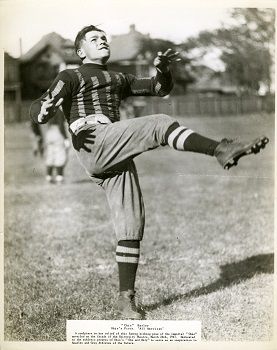COLUMBUS, Ohio — In 1921 then-Ohio State University President William Oxley Thompson called the push to build Ohio Stadium, the university’s “greatest single enterprise.”
What You Need To Know
- In 1916, Chic Harley brought OSU national attention, securing the team’s first Western Conference Championship, contributing to growing interest in the team and providing the impetus for building Ohio Stadium
- Ohio Stadium was designed by Architect Howard Dwight Smith who was inspired by a trip to Rome
- The stadium was the first concrete, double deck horseshoe stadium in the country
- Ohio Stadium was constructed from more than 40,000 cubic yards of concrete and 4,000 tons of steel and in 1922 was the largest stadium west of the Appalachian Mountains
College football was on the upswing, attracting unprecedented numbers of spectators, fans and dollars.
The size of Ohio Field couldn’t keep up with the sport’s popularity. Many games had visitors hanging from tree branches and walls, trying to get a view of the field.

The increased interest in games came in 1916 when Ohio State player and All-American Chic Harley brought OSU national attention by securing the team’s first Western Conference championship
Stadium architect Howard Dwight Smith, a Buckeye himself, was enlisted to design the new stadium. His plans combined features from two East Coast powerhouse football program’s stadiums: the bowl-shape of Yale’s stadium and the permanent bleachers running the length of the field similar to those at Harvard.
But it’s the horseshoe, the signature U-shape, that defines Ohio Stadium.
“When Howard Dwight Smith designed the stadium the way he did, to hold 66,000 people, people thought he was crazy,” said Columbus Dispatch sports reporter Bill Rabinowitz.
Football had not taken hold of the national consciousness yet and the university was taking a risk, betting that the sport would grow alongside the school.
The effort that went into raising money for the build was unprecedented. The decision not to use taxpayer dollars led to a seven-month campaign filled with parades, posters and speeches to rally private donations.
Across the campus, loud-speaker fundraising announcements rang out, as did a call for contributions from all 88 Ohio counties.
“It was the impetus for what is now the alumni database,” said Ohio State archivist Tamar Chute. “And the goal was to raise $1 million.”
Of course, a stadium is nothing without what happens on its grounds and Ohio Stadium has a rich history of historic moments.
“This is a house of worship,” said Columbus Dispatch sports columnist Rob Oller. “100 years of people gathering, to cheer on the Buckeyes… it’s special because of the special things that happened inside of it; Archie Griffin and Jesse Owens and Woody Hayes, Jim Tressel….”
Ohio Stadium opened Oct. 7, 1922, and the Buckeyes beat Ohio Wesleyan University 5-0 that day.
The stadium’s formal dedication was at the Ohio State versus Michigan game two weeks later in front of 71,385 fans. The crowd was greeted with patriotic speeches, songs, and a 21-gun salute.
According to university records, vendors sold 10,000 hot dogs, 70,000 bottled sodas, 8,000 boxes of Cracker Jack, 70 gallons of coffee and went through 25 gallons of mustard.
The result against Michigan was the only disappointment of the day. The Buckeyes lost 19-0.



